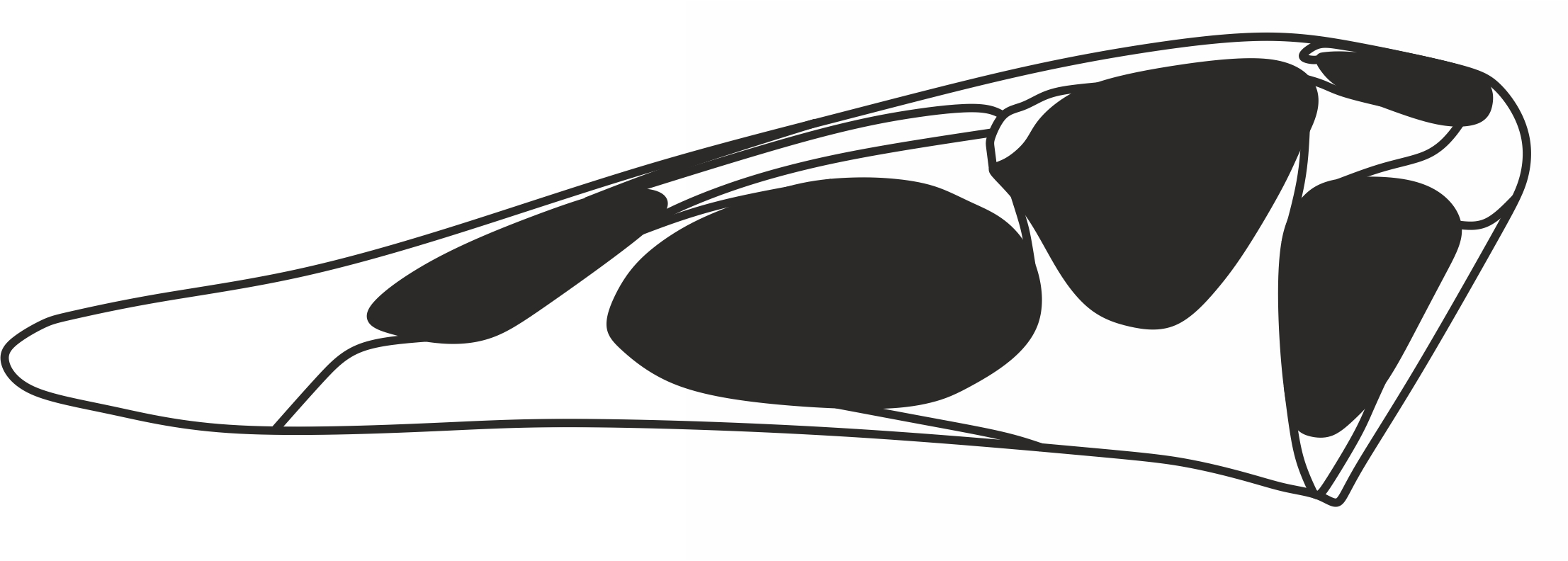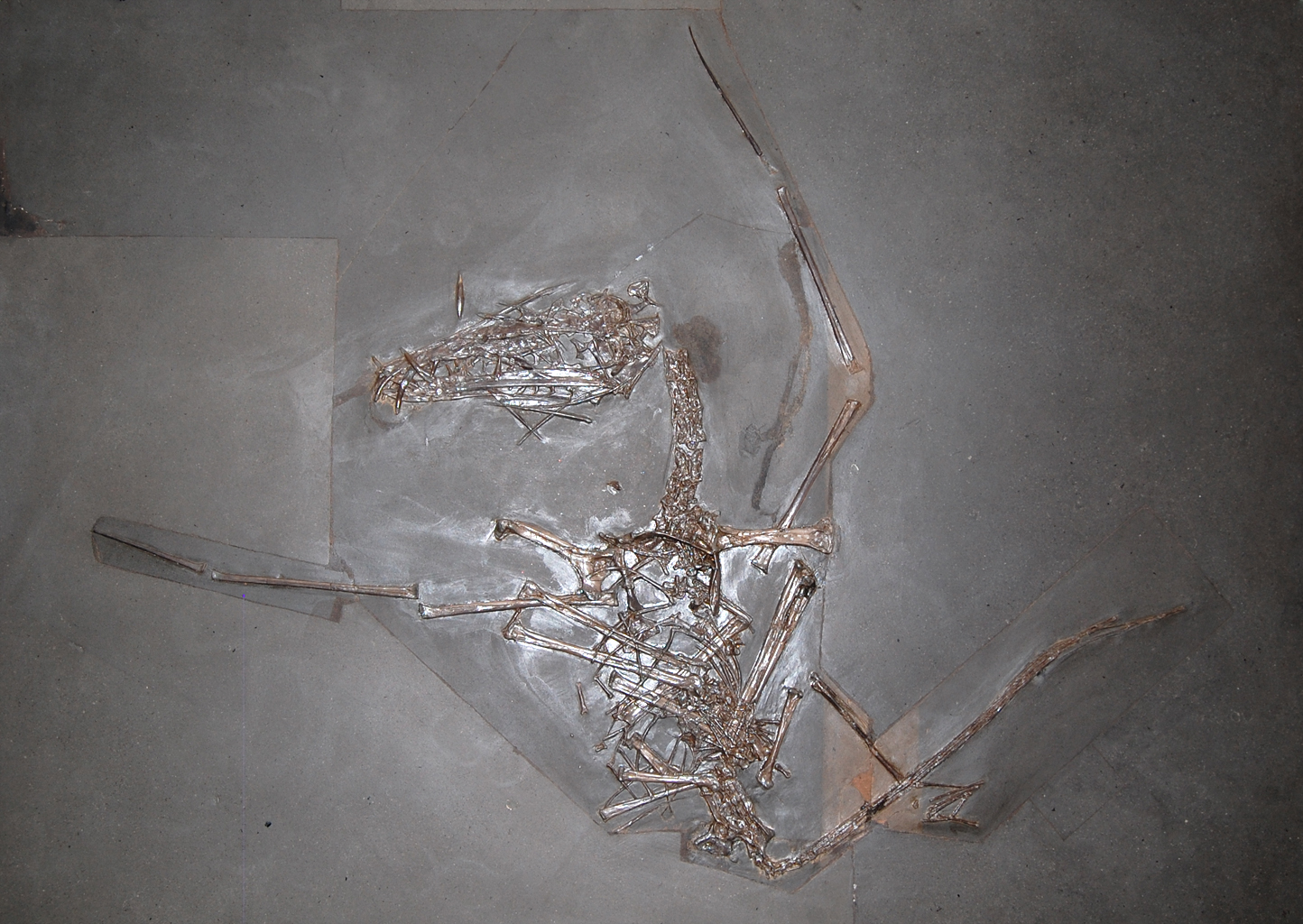|
Rhamphorhynchidae
Rhamphorhynchidae is a group of early pterosaurs named after ''Rhamphorhynchus'', that lived in the Late Jurassic. The family Rhamphorhynchidae was named in 1870 by Harry Govier Seeley.Seeley, H.G. (1870). "The Orithosauria: An Elementary Study of the Bones of Pterodactyles." Cambridge, 135 p. Members of the group possess no more than 11 pairs of teeth in the rostrum, a deltopectoral crest that is constricted at the base but expanded at the distal end, and a bent phalange on the fifth toe. Rhamphorhynchidae traditionally contains two subfamilies: the Rhamphorhynchinae and the Scaphognathinae. While not recovered as distinct clades by all analyses, there do appear to be traits uniting members of each group. Rhamphorhynchines are more common, were lightly built, and had jaws ending in pointed tips that contained more teeth, which are often procumbent (pointed forward). Scaphognathines are comparatively quite rare, were more robust skeletally, and had shorter wing proportions. The b ... [...More Info...] [...Related Items...] OR: [Wikipedia] [Google] [Baidu] |
Parapsicephalus
''Parapsicephalus'' (meaning "beside arch head") is a genus of long-tailed rhamphorhynchid pterosaurs from the Lower Jurassic Whitby, Yorkshire, England. It contains a single species, ''P. purdoni'', named initially as a species of the related rhamphorhynchid ''Scaphognathus'' in 1888 but moved to its own genus in 1919 on account of a unique combination of characteristics. In particular, the top surface of the skull of ''Parapsicephalus'' is convex, which is otherwise only seen in dimorphodontians. This has been the basis of its referral to the Dimorphodontia by some researchers, but it is generally agreed upon that ''Parapsicephalus'' probably represents a rhamphorhynchid. Within the Rhamphorhynchidae, ''Parapsicephalus'' has been synonymized with the roughly contemporary ''Dorygnathus''; this, however, is not likely given the many differences between the two taxa, including the aforementioned convex top surface of the skull. ''Parapsicephalus'' has been tentatively referred to t ... [...More Info...] [...Related Items...] OR: [Wikipedia] [Google] [Baidu] |
Rhamphorhynchus
''Rhamphorhynchus'' (, from Ancient Greek ''rhamphos'' meaning "beak" and ''rhynchus'' meaning "snout") is a genus of long-tailed pterosaurs in the Jurassic period. Less specialized than contemporary, short-tailed pterodactyloid pterosaurs such as ''Pterodactylus'', it had a long tail, stiffened with ligaments, which ended in a characteristic soft-tissue tail vane. The mouth of ''Rhamphorhynchus'' housed needle-like teeth, which were angled forward, with a curved, sharp, beak-like tip lacking teeth, indicating a diet mainly of fish; indeed, fish and cephalopod remains are frequently found in ''Rhamphorhynchus'' abdominal contents, as well as in their coprolites. Although fragmentary fossil remains possibly belonging to ''Rhamphorhynchus'' have been found in England, Tanzania, and Spain, the best preserved specimens come from the Solnhofen limestone of Bavaria, Germany. Many of these fossils preserve not only the bones but impressions of soft tissues, such as wing membranes. Scat ... [...More Info...] [...Related Items...] OR: [Wikipedia] [Google] [Baidu] |
Pterodactylus Longicaudus
''Rhamphorhynchus'' (, from Ancient Greek ''rhamphos'' meaning "beak" and ''rhynchus'' meaning "snout") is a genus of long-tailed pterosaurs in the Jurassic period. Less specialized than contemporary, short-tailed pterodactyloid pterosaurs such as ''Pterodactylus'', it had a long tail, stiffened with ligaments, which ended in a characteristic soft-tissue tail vane. The mouth of ''Rhamphorhynchus'' housed needle-like teeth, which were angled forward, with a curved, sharp, beak-like tip lacking teeth, indicating a diet mainly of fish; indeed, fish and cephalopod remains are frequently found in ''Rhamphorhynchus'' abdominal contents, as well as in their coprolites. Although fragmentary fossil remains possibly belonging to ''Rhamphorhynchus'' have been found in England, Tanzania, and Spain, the best preserved specimens come from the Solnhofen limestone of Bavaria, Germany. Many of these fossils preserve not only the bones but impressions of soft tissues, such as wing membranes. Scat ... [...More Info...] [...Related Items...] OR: [Wikipedia] [Google] [Baidu] |
Bellubrunnus
''Bellubrunnus'' (meaning "the beautiful one of Brunn" in Latin) is an extinct genus of rhamphorhynchid pterosaur from the Late Jurassic (Kimmeridgian stage) of southern Germany. It contains a single species, ''Bellubrunnus rothgaengeri''. ''Bellubrunnus'' is distinguished from other rhamphorhynchids by its lack of long projections on the vertebrae of the tail, fewer teeth in the jaws, and wingtips that curve forward rather than sweep backward as in other pterosaurs. Discovery ''Bellubrunnus'' is known from a single complete articulated skeleton, the holotype of the genus, having the accession number BSP–1993–XVIII–2. It was found in the summer of 2002 by an excavation team led by Monika Rothgaenger, the namesake of the species. It was prepared in 2003 by Martin Kapitzke and at first identified as an exemplar of ''Rhamphorhynchus''. It is preserved in ventral view, meaning that the underside of the skeleton can be seen on the limestone slab. The specimen is currently house ... [...More Info...] [...Related Items...] OR: [Wikipedia] [Google] [Baidu] |
Pterosaur
Pterosaurs (; from Greek ''pteron'' and ''sauros'', meaning "wing lizard") is an extinct clade of flying reptiles in the order, Pterosauria. They existed during most of the Mesozoic: from the Late Triassic to the end of the Cretaceous (228 to 66 million years ago). Pterosaurs are the earliest vertebrates known to have evolved powered flight. Their wings were formed by a membrane of skin, muscle, and other tissues stretching from the ankles to a dramatically lengthened fourth finger. There were two major types of pterosaurs. Basal pterosaurs (also called 'non-pterodactyloid pterosaurs' or 'rhamphorhynchoids') were smaller animals with fully toothed jaws and, typically, long tails. Their wide wing membranes probably included and connected the hind legs. On the ground, they would have had an awkward sprawling posture, but the anatomy of their joints and strong claws would have made them effective climbers, and some may have even lived in trees. Basal pterosaurs were insectiv ... [...More Info...] [...Related Items...] OR: [Wikipedia] [Google] [Baidu] |
Angustinaripterus
''Angustinaripterus'' was a basal pterosaur, belonging to the breviquartossan family Rhamphorhynchidae (more specifically within the subfamily Rhamphorhynchinae) and discovered at Dashanpu near Zigong in the Sichuan province of China. Discovery and etymology ''Angustinaripterus'' was named in 1983 by He Xinlu. The type species is ''Angustinaripterus longicephalus''. The genus name is derived from Latin ''angustus'', "narrow" and ''naris'', "nostril", combined with Latinized Greek ''pteron'', "wing". The specific name is derived from Latin ''longus'', "long", and Greek ''kephale'', "head". The holotype, ZDM T8001, is a single skull with lower jaws, found in 1981 by researchers from the Zigong Historical Museum of the Salt Industry, in the Xiashaximiao Formation (Bathonian). Description The skull of ''Angustinaripterus'', of which the left side is severely damaged, is very elongated and flat. The back part is missing; in its preserved state it has a length of ; the total le ... [...More Info...] [...Related Items...] OR: [Wikipedia] [Google] [Baidu] |
Qinglongopterus
''Qinglongopterus'' is a genus of rhamphorhynchid pterosaur from the Middle/Upper Jurassic of Mutoudeng, Qinglong County, Hebei Province, China. ''Qinglongopterus'' is known from only one specimen; D3080/3081, a nearly complete skeleton collected from the Tiaojishan Formation. It was described by Lü Junchang ''et al.'' in 2012. The type species is ''Qinglongopterus guoi''. Description ''Qinglongopterus'' is noted to be remarkably similar to ''Rhamphorhynchus'', although ''Qinglongopterus'' has a proportionally smaller head and shorter wings. In the original description, the authors suggest ''Rhamphorhynchus'' may even be descended from ''Qinglongopterus'' due to the large number of shared characters between the two genera. ''Qinglongopterus'' appears approximately 10 million years earlier than ''Rhamphorhynchus,'' yet possesses many derived traits for the group. This may be evidence of evolutionary stasis within rhamphorhynchine pterosaurs. The holotype specimen has large ... [...More Info...] [...Related Items...] OR: [Wikipedia] [Google] [Baidu] |
Breviquartossa
Novialoidea (meaning "new wings") is an extinct clade of macronychopteran pterosaurs that lived from the latest Early Jurassic to the latest Late Cretaceous (early Toarcian to late Maastrichtian ageBarrett, P. M., Butler, R. J., Edwards, N. P., & Milner, A. R. (2008). Pterosaur distribution in time and space: an atlas. ''Zitteliana'', 61-107/ref>), their fossils having been found on all continents except Antarctica. History and classification Novialoidea was named by paleontologist Alexander Wilhelm Armin Kellner in 2003 as a node-based taxon consisting of the last common ancestor of ''Campylognathoides'', ''Quetzalcoatlus'' and all its descendants. This name was derived from Latin ''novus'' "new", and ''ala'', "wing", in reference to the wing synapomorphies that the members of the clade possess.Kellner, A. W. A., (2003): Pterosaur phylogeny and comments on the evolutionary history of the group. pp. 105-137. — ''in'' Buffetaut, E. & Mazin, J.-M., (eds.): ''Evolution and Pal ... [...More Info...] [...Related Items...] OR: [Wikipedia] [Google] [Baidu] |
Dolicorhamphus
''Dolicorhamphus'' is an extinct genus of pterosaurs from the Middle Jurassic Taynton Limestone Formation and Fuller's Earth Formations of England. The genus contains two species, ''D. bucklandii'' and ''D. depressirostris''. Both species of ''Dolicorhamphus'' were assigned to the wastebasket genus '' Rhamphocephalus'', considered a "rhamphorhynchoid" pterosaur. However, the type species of ''Rhamphocephalus'', ''R. prestwichii'', was reinterpreted as a thalattosuchian by O'Sullivan and Martill on 2018, but ''"R." depressirostris'' and ''"R." bucklandii'' were clearly pterosaurian; the former was considered to be in the Scaphognathinae while the latter was only referred to a more general Rhamphorhynchidae. Andres (2021) resurrected the genus ''Dolicorhamphus'' for the two, finding it to be a valid genus of pterosaurs closely related to ''Klobiodon'', although he did not assign a type species. This generic assignment has since been followed by other researchers. ''D. bucklandi'' i ... [...More Info...] [...Related Items...] OR: [Wikipedia] [Google] [Baidu] |
Klobiodon
''Klobiodon'' is a genus of rhamphorhynchid pterosaur from the Middle Jurassic Taynton Limestone Formation of Oxfordshire, England. Etymology The type species of ''Klobiodon'' is ''Klobiodon rochei''. The generic name ''Klobiodon'' means "small cage tooth," from the Greek κλωβίον, ''klobion'', "little cage", and ὀδών, ''odon'', "tooth", in reference to the large anterior laniaries that appear to form a fish grab, while the specific name ''rochei'' honors the comic book artist Nick Roche for his anatomically correct designs inspired by dinosaurs. History The holotype of ''Klobiodon rochei'', NHMUK PV OR 47991, was first mentioned by George Robert Waterhouse (1878) as part of the collection of the British Museum of Natural History, where he mentions Richard Owen intended to name the specimen ''Pterodactylus raptor'' in an unpublished manuscript. It had been donated by Robert Marsham. Richard Lydekker (1888) referred the specimen to ''Rhamphorhynchus depressirostris'' ( ... [...More Info...] [...Related Items...] OR: [Wikipedia] [Google] [Baidu] |
Dorygnathus Banthensis
''Dorygnathus'' ("spear jaw") was a genus of rhamphorhynchid pterosaur that lived in Europe during the Early Jurassic period, when shallow seas flooded much of the continent. It had a short () wingspan, and a relatively small triangular sternum, which is where its flight muscles attached. Its skull was long and its eye sockets were the largest opening therein. Large curved fangs that "intermeshed" when the jaws closed featured prominently at the front of the snout while smaller, straighter teeth lined the back. Having two or more morphs of teeth, a condition called heterodonty, is rare in modern reptiles but more common in basal ("primitive") pterosaurs. The heterodont dentition in ''Dorygnathus'' is consistent with a piscivorous (fish-eating) diet. The fifth digit on the hindlimbs of ''Dorygnathus'' was unusually long and oriented to the side. Its function is not certain, but the toe may have supported a membrane like those supported by its wing-fingers and pteroids. ''Dorygnathus ... [...More Info...] [...Related Items...] OR: [Wikipedia] [Google] [Baidu] |
Jianchangopterus
''Jianchangopterus'' is a genus of scaphognathine rhamphorhynchid pterosaur from the Middle Jurassic of western Liaoning, China. ''Jianchangopterus'' is known from a nearly complete skeleton with skull preserved. It was collected from the Tiaojishan Formation. It was first named (after Jianchang County) by Lü Junchang and Bo Xue in 2011 and the type species is ''Jianchangopterus zhaoianus''. See also * List of pterosaur genera * Timeline of pterosaur research This timeline of pterosaur research is a chronologically ordered list of important fossil discoveries, controversies of interpretation, and taxonomic revisions of pterosaurs, the famed flying reptiles of the Mesozoic era. Although pterosaurs w ... References Middle Jurassic pterosaurs of Asia Rhamphorhynchids Fossil taxa described in 2011 Taxa named by Lü Junchang Paleontology in Liaoning {{Pterosaur-stub ... [...More Info...] [...Related Items...] OR: [Wikipedia] [Google] [Baidu] |




